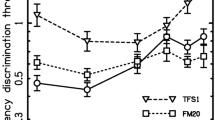Abstract
In our research, we determined the dependence of human detection of differences in the sound stimulus transition process, upon sound intensity and frequency. We established that the discrimination threshold for the stimulus rise time (Δτr) is approximately 1.5 msec at low and intermediate tone frequencies and increases to 5–6 msec during an increase in frequency from 10 to 15 kHz. It was shown that the ability of a human to discriminate a stepwise change in the stimulus envelope depends upon the duration of the steps. For steps of short duration (up to 7 msec), a linear decrease in the discrimination threshold value for detecting a drop in step amplitude (ΔI) occurs with increasing duration of the step (t). For a step duration greater than 7 msec, the discrimination threshold for a drop in amplitude remains constant, equaling a value on the order of 3.5 dB. It was found that the values of Δτr and ΔI rapidly decrease with an increasing level of stimulus intensity in the range of 10–40 dB and remain practically constant in the range of 40–80 dB.
Similar content being viewed by others
Literature cited
Ya. A. Al'tman, I. A. Vartanyan, and E. A. Radionova, “Electrical phenomena associated with the activity of pathways and centers of the auditory system,” Nauka, Leningrad (1972), pp. 210–260.
G. V. Gershuni and N. V. Zaboeva, “Evaluation of the functional significance of electrical responses of the auditory system,” Fiziol. Zh. SSSR,48, 10, 1178–1186 (1962).
G. V. Gershuni, “Mechanisms of Hearing (in connection with the study of the time and time-frequency characteristics of hearing),” in: Mechanisms of Hearing [in Russian], Nauka, Leningrad (1967), pp. 3–31.
G. V. Gershuni, R. V. Avakyan, A. V. Baru, and N. I. Mironova, “Discrimination of sounds with various rise times,” in: The Evolution of Functions [in Russian], Nauka, Leningrad (1964), pp. 66–71.
N. V. Zaboeva, “Dependence of total electrical responses of the peripheral part of the auditory analyzer upon the steepness of the stimulus rise,” Fiziol. Zh. SSSR,52, 4, 346–354 (1966).
E. V. Kozhevnikova, “Natural classification of auditory stimuli with various lag times in the step of the envelope,” Fiziol. Zh. SSSR,64, 12, 1815–1820 (1978).
O. N. Stukova and M. G. Zhukova, “Completely phasic neurons of the inner geniculate body — markers of changes in the signal,” Fiziol. Zh. SSSR,71, 8, 971–975 (1985).
É. Tsviker and R. Fel'dkeller, The Ear as a Receiver of Information [in Russian], Svyaz', Moscow (1972).
R. Efron, “Effect of stimulus duration on perception of onset and offset latencies,” Percept. Psychophys.,32, 409–418 (1982).
J. M. Hary and D. W. Massaro, “Categorial results do not imply categorial perception,” Percept. Psychophys.,32, 409–418 (1982).
V. J. Heuvan and M. P. Broeke, “Auditory discrimination of rise and decay times in tone and noise bursts,” J. Acoust. Am.,66, 5, 1308–1315 (1979).
D. Kewley-Port and D. Pisoni, “Identification and discrimination of rise time: is it categorial or noncategorial?” J. Acoust. Soc. Am.,15, 4, 1168–1176 (1984).
J. Pollack, “Onset discrimination for white noise,” J. Acoust. Soc. Am.,35, 4, 607–609 (1963).
Author information
Authors and Affiliations
Additional information
Translated from Fiziologicheskii Zhurnal SSSR imeni I. M. Sechenova, Vol. 73, No. 8, pp. 1078–1083, August, 1987.
Rights and permissions
About this article
Cite this article
Kalmylova, I.V., Shakhshaev, S.A. Effects of tone intensity and frequency on discrimination of the sound stimulus transition process. Neurosci Behav Physiol 18, 378–383 (1988). https://doi.org/10.1007/BF01193882
Received:
Issue Date:
DOI: https://doi.org/10.1007/BF01193882




